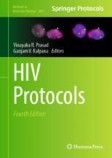Search
Search Results
-
Quantification of Site-Specific 5-Formylcytosine by Integrating Peptide Nucleic Acid-Clamped Ligation with Loop-Mediated Isothermal Amplification
The precise sensing of 5-formylcytosine (5fC) is of great significance because 5fC not only determines the nucleosome organization that regulates...
-
Proximity Ligation Assay to Detect the Proximity Between Host Proteins and Viral Proteins of HIV-1
The study of host-pathogen interaction often requires interrogating the protein-protein interactions and examining post-translational modifications...
-
Pylorus ligation-induced hyperacidity: synergistic prophylactic effects of linagliptin and L-arginine via up-regulation of EP4 receptor subtype and improvement of vascular endothelial damage
Gastric hyperacidity and ulceration are chronic diseases characterized by repeated healing followed by re-exacerbation. The study aims to protect...

-
Detection of viral RNAs at ambient temperature via reporter proteins produced through the target-splinted ligation of DNA probes
Nucleic acid assays are not typically deployable in point-of-care settings because they require costly and sophisticated equipment for the control of...

-
Identification of two novel large deletions in FBN1 gene by next-generation sequencing and multiplex ligation-dependent probe amplification
BackgroundMutations in fibrillin-1 ( FBN1 ) are known to be associated with Marfan syndrome (MFS), an autosomal dominant connective tissue disorder....

-
Investigating the efficacy of dapsone in treating sepsis induced by cecal ligation and puncture surgery in male mice
Sepsis is a life-threatening condition caused by the body’s response to an infection. Dapsone is a sulfone with antibiotic properties, and...

-
Application of a Multiplex Ligation-Dependent Probe Amplification-Based Next-Generation Sequencing Approach for the Detection of Pathogenesis of Duchenne Muscular Dystrophy and Spinal Muscular Atrophy Caused by Copy Number Aberrations
Both Duchenne muscular dystrophy (DMD; OMIM no. 310200) and spinal muscular atrophy (SMA; OMIM no. 253300/253550/253400/271150) are genetic disorders...

-
Activation of Cannabinoid Receptor 1 in GABAergic Neurons in the Rostral Anterior Insular Cortex Contributes to the Analgesia Following Common Peroneal Nerve Ligation
The rostral agranular insular cortex (RAIC) has been associated with pain modulation. Although the endogenous cannabinoid system (eCB) has been shown...

-
Severe Combined Immunodeficiency from a Homozygous DNA Ligase 1 Mutant with Reduced Catalytic Activity but Increased Ligation Fidelity
A cell’s ability to survive and to evade cancer is contingent on its ability to retain genomic integrity, which can be seriously compromised when...

-
Implementing a novel capture and ligation probe-PCR method in mass screen and treatment to support malaria elimination efforts in the China-Myanmar border region
BackgroundMass screening and treatment (MSAT) for malaria elimination lacks an ideal diagnostic tool to allow sensitive and affordable test of the...

-
Circular RNA Tmcc1 improves astrocytic glutamate metabolism and spatial memory via NF-κB and CREB signaling in a bile duct ligation mouse model: transcriptional and cellular analyses
BackgroundHepatic encephalopathy-induced hyperammonemia alters astrocytic glutamate metabolism in the brain, which is involved in cognitive decline....

-
RedOx regulation of LRRK2 kinase activity by active site cysteines
Mutations of the human leucine-rich repeat kinase 2 (LRRK2) have been associated with both, idiopathic and familial Parkinson’s disease (PD). Most of...

-
The ligation between ERMAP, galectin-9 and dectin-2 promotes Kupffer cell phagocytosis and antitumor immunity
Kupffer cells, the liver tissue resident macrophages, are critical in the detection and clearance of cancer cells. However, the molecular mechanisms...

-
LUMI-PCR: an Illumina platform ligation-mediated PCR protocol for integration site cloning, provides molecular quantitation of integration sites
BackgroundLigation-mediated PCR protocols have diverse uses including the identification of integration sites of insertional mutagens, integrating...

-
New Frontiers for Site-Directed RNA Editing: Harnessing Endogenous ADARs
RNA editing activity can be exploited for the restoration of disease-causing nonsense and missense mutations and as a tool to manipulate the...
-
Addition of an affected family member to a previously ascertained autosomal recessive nonsyndromic hearing loss pedigree and systematic phenotype-genotype analysis of splice-site variants in MYO15A
Pathogenic variants in MYO15A are known to cause autosomal recessive nonsyndromic hearing loss (ARNSHL), DFNB3. We have previously reported on one...

-
An Improved Monkey Model of Myocardial Ischemic Infarction for Cardiovascular Drug Development
Non-human primate monkey model of myocardial ischemic infarction is precious for translational medicine research. Ligation of the left anterior...

-
Tau-proximity ligation assay reveals extensive previously undetected pathology prior to neurofibrillary tangles in preclinical Alzheimer’s disease
BackgroundMultimerization is a key process in prion-like disorders such as Alzheimer’s disease (AD), since it is a requirement for self-templating...

-
A novel splice site variant c.1183 + 1 G > C in DFNA5 causing autosomal dominant nonsyndromic hearing loss in a Chinese family
BackgroundThe most frequent clinical presentation of autosomal dominant nonsyndromic hearing loss (ADNSHL) is bilateral, symmetrical, postlingual...

-
Use of Toll-Like Receptor (TLR) Ligation to Characterize Human Regulatory B-Cells Subsets
Toll-like receptors (TLRs) are pattern recognition receptors (PRRs), which constitute key components in the recognition of pathogens, thereby...
